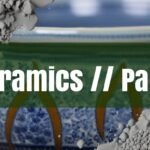Purchasing ceramics to paint offers a wonderful avenue for creative expression, allowing individuals to personalize pieces with unique designs and colors. Whether you’re a seasoned artist or a beginner looking to explore a new hobby, understanding where to source your ceramics and how to prepare them is key to a successful and enjoyable painting experience.
Where to buy ceramics to paint
When looking for ceramics to paint, several options are available, each with its own advantages and considerations. Major craft store chains like Michael’s and Hobby Lobby are often the first stop for many. These stores provide a wide selection of bisque, which is unglazed, fired ceramic ware ready for painting. The pros of shopping at these retailers include their accessibility, frequent sales and discounts, and the ability to physically examine the pieces before purchasing. However, the selection may be limited to more common shapes and designs, and the quality can vary.
Online marketplaces such as Etsy and Amazon offer a vast array of ceramic pieces from individual artists and small businesses. This can be a great way to find unique and unusual items that you won’t find in big-box stores. The cons include the inability to inspect the items in person before buying, potential shipping costs, and the need to carefully read product reviews to ensure quality and reliability. Specialized ceramic suppliers are another excellent option, particularly for those looking for specific types of clay or more professional-grade bisque. These suppliers often carry a wider range of shapes and sizes, and the quality is generally more consistent. However, they may require minimum order quantities and could be less accessible to casual hobbyists.
Local pottery studios and independent ceramic artists can also be valuable sources for ceramics to paint. Purchasing from these sources supports local artisans and provides the opportunity to acquire unique, high-quality pieces. You may even find studios that offer classes where you can create your own pottery and then paint it. The downside is that these options may be more expensive, and the selection may be limited to the artist’s particular style. When selecting ceramics for painting, consider the type of clay used. Earthenware is a common choice for beginners due to its affordability and ease of use. Stoneware is more durable and suitable for functional pieces, while porcelain offers a smooth, refined surface ideal for detailed painting. The surface texture of the ceramic is also important; a smooth surface is best for intricate designs, while a textured surface can add depth and interest to simpler patterns. Additionally, ensure the ceramic is suitable for the painting techniques you plan to use. Some paints require firing, while others are air-dry and require a sealant. Always factor in shipping costs, minimum order quantities, and the importance of reading product reviews before making a purchase.
Ceramic Paints and Their Safe Use
Navigating the world of ceramic paints requires an understanding of the different types available, their specific properties, and any safety considerations that come with their use. As modern technology advances, the lines between different categories of paints have blurred, allowing for more versatile applications. However, this also means it’s crucial to carefully read the instructions for each paint to ensure the desired outcome and, more importantly, to ensure safety, especially when painting ceramics that will be used for food or drink.
From a safety perspective, the primary concern is whether the paint is food-safe, particularly if you’re painting items intended for consumption. Paints can be applied at various stages of the ceramic production process; some are suitable for raw, wet ceramics, while others are designed for glazed, fired pieces. Another critical factor is the temperature the paint can withstand if the ceramic needs to be fired after painting. The paint and glaze must be able to endure the firing process to achieve the correct result. Some paints are suitable for storing or holding food after firing without needing an additional layer of glaze, while others require a glaze to prevent unhealthy substances from leaching into food. Acrylic paint is a fantastic option for decorative ceramics that won’t be used for food, as it adheres beautifully and is waterproof once dry. It’s also possible to paint new patterns on already-fired and glazed ceramics using specific paints, such as those used in porcelain painting.
Ceramic paints can be categorized based on when they are applied during the ceramic production process. Underglazes are applied before glazing and are absorbed into the ceramic material itself, making them highly resistant. Fusible enamels are applied to glazed ceramics but sink into or underneath the glaze when fired. Paints applied above the glaze, such as porcelain paintings and lustres, remain on the surface and are not protected by the glaze. When using glaze paints, it’s essential to choose a modern glaze paint that offers a wide range of colors and allows for mixing to create custom shades. To make creations as durable and usable as possible, consider coating them with a clear glaze. When working with glazes, be aware that they are a mixture of silica, fluxes, and colorants. The colorants, often metal oxides, typically make up less than 5% of the glaze by weight. Some glazes, especially luster or metallic glazes, may contain hazardous substances like mercury, arsenic, and toxic solvents. Always use lead-free glazes and avoid colorants known to be human carcinogens. When handling powdered glazes, wear a respirator to avoid inhalation. Wet glazes are not an inhalation hazard, but gloves should be worn while handling them.
Surface Preparation Techniques
Properly preparing ceramic surfaces before painting is crucial for ensuring proper adhesion and a smooth finish. This preparation prevents paint from peeling or chipping, resulting in a professional-looking outcome. Just as in the detailing world, preparation is key in ceramic painting.
The first step is to ensure that the surface is as clean as possible. Begin by washing the ceramic piece thoroughly to remove any dust, dirt, or oils. For this, you can use a wax-free, gloss-free soap to strip away any leftover sealants, waxes, or glazes. If the ceramic has any existing residues or surface contaminants, use an IPA (Isopropyl Alcohol) based solution to remove them. Products like Adam’s Surface Prep are designed to leave surfaces bare and free of any residue, making them ideal for this step. Spray the surface prep onto a clean microfiber towel and wipe the ceramic, ensuring you cover the entire surface thoroughly. Any missed areas risk having a faulty substrate underneath, which can prevent the coating from adhering correctly.
For surfaces that have imperfections, consider using a clay bar to remove any surface contamination that washing might have missed. If necessary, machine polish the ceramic to remove any swirl marks or scratches. After polishing, it’s important to remove any remaining oils, waxes, or silicones. Use a cleansing wipe-down with a product like Wipe Out Surface Cleanser Spray to ensure the surface is entirely residue-free. Work in sections, spraying the cleanser directly onto the surface and wiping it away with a clean, lint-free microfiber towel. CCI’s Coating Prep is also an excellent option for removing compounds, polishes, waxes, and grease from any surface quickly and easily. This product ensures the proper adhesion of ceramic coatings, which will increase the longevity of the coating. By taking these steps, you create a clean and receptive surface, which maximizes the durability and performance of your paint.
Tools, Techniques, and Design Ideas
Selecting the right tools and understanding various painting techniques are essential for achieving the desired effects on your painted ceramics. The tools you use can significantly influence the final appearance, allowing you to create a wide range of designs from simple to intricate.
Brushes are fundamental for ceramic painting. Natural bristle brushes are excellent for applying materials like slip or glaze consistently because the follicles of the natural hair hold more material than synthetic brushes. However, a synthetic brush is preferable when applying wax resist, as it offers more precision and doesn’t soak up as much material. Sponges are also essential for adding and removing water, smoothing surfaces, and general cleanup. Having a variety of sponges in different sizes, shapes, and textures is useful for different applications. Sponges can also be used to apply glaze for a textured appearance or remove glaze as needed.
Other useful tools include ribs, which are flat tools used for smoothing and shaping on the wheel, and scrapers, which are flat and oval-shaped tools used for smoothing and cutting clay. Wooden modeling tools, with their angled or pointed ends, are great for fine work and getting into tight spaces. Loop and ribbon tools are shaped cutting tools with stainless steel ribbon heads, used for trimming clay pieces on the wheel once they reach the leather-hard stage. Needle tools, with their sharp metal needles set in handles, are used for cutting, piercing, measuring clay depth, and creating patterns. For applying surface materials with precision, squeeze bottles with interchangeable tips are invaluable. These allow you to concentrate and control the application of slip, underglaze, or glaze. For paints, liquid latex or acrylic paints are best for decorating pottery at home. Glaze, which gives ceramics a smooth, glass-like surface, is available in many colors and is used to decorate and waterproof pieces.
When it comes to design ideas, there are countless possibilities for both beginners and experienced artists. Simple polka dots or stripes can add charm and flair to any ceramic piece. More advanced techniques include creating marble effects by swirling different colored paints together or painting delicate floral patterns for a touch of nature. Geometric designs, ombre effects, and animal silhouettes are also popular choices. You can also explore abstract designs, seasonal motifs, or personalized designs with initials or names. For those looking to build paint opacity, apply thin layers of paint, allowing each layer to dry before adding another. Ceramic medium can be used to increase the translucency of the paint, creating glaze and watercolor effects. Sponges are great for creating dimensional designs, while lace can be used as a stencil to add intricate details. Splattering paint with a toothbrush or firm brush is another fun technique for adding texture and visual interest. Mandala patterns, floral designs, and animal portraits are all excellent ways to showcase your artistic skills.
Sealing and Finishing
Properly sealing and finishing painted ceramics is essential for protecting the design, enhancing durability, and achieving different aesthetic effects. Sealing protects the painted surface from scratches, fading, and general wear, ensuring your artwork remains vibrant and intact over time.
Before sealing, ensure your paint is completely dry. Apply your chosen sealant in a well-ventilated area, using even strokes to cover the entire painted area. Follow the manufacturer’s instructions for drying times to ensure the best protection. Some sealants may require baking in an oven to cure. Water-based polyurethane varnish, clear acrylic coat, or Mod Podge are common sealants for acrylic paint on ceramic plates. Sealing creates a barrier that prevents moisture, oils, and food stains from penetrating the paint layer, making the surface easier to clean. Over time, you may need to reapply the sealant to maintain its protective layer. Sealants can also add a glossy or matte finish, enhancing the visual appeal of your ceramic pieces.
If you want your piece to be waterproof, ensure your clay body is fired to the right temperature. Low-fire clay is not waterproof. For decorative pieces, you can use Duncan spray and brush-on sealers, which protect the paint from chipping and smudging and add shine if desired. For pieces that will come into contact with food or drink, use only glazes that are specifically for food or dinnerware. Proper firing of food-safe glazes is critical. If glazed surfaces are crazed, blistered, underfired, or otherwise defective, they may not be food safe. By carefully sealing and finishing your painted ceramics, you can create long-lasting, visually appealing pieces that can be enjoyed for years to come. These final coatings produce smooth, hard surfaces, brighten colors, and protect the finishes of objects decorated with nonfired color products.





